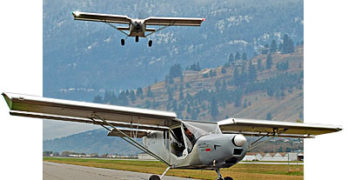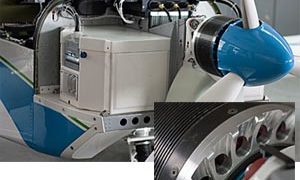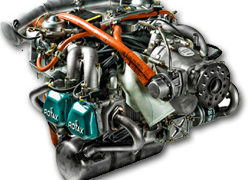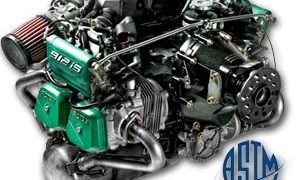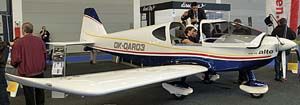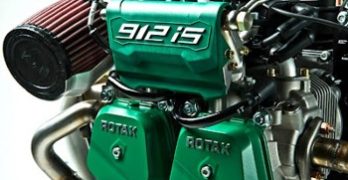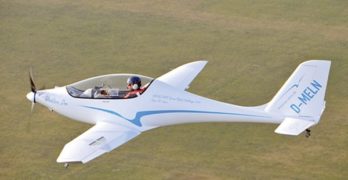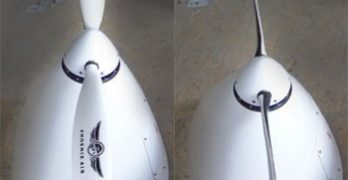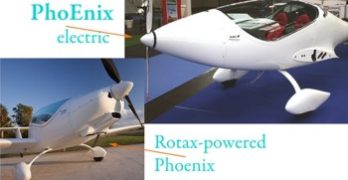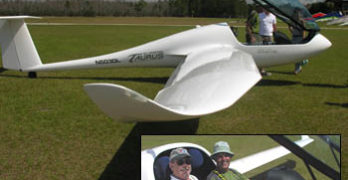Zenith Aircraft is one of the country or world’s most successful providers of kit aircraft. Several thousands of all models are flying. One of their most popular is the “Sky Jeep,” otherwise known by the more pedestrian designation, CH 750. Plenty of reasons tell the story of why Zenith in Mexico, Missouri can sell solidly through good times and bad but arguably one of the most important is the company’s support for many different engines. Since Zenith sells Experimental Amateur Built (51%) kits, owners can install whatever they like and Zenith supports multiple engine installations. Now, they’ve added one of the very newest: Rotax BRP’s fuel injected 912iS. Zenith now offers the 912iS as an engine choice from a list of powerplants that includes the 100-hp 912 ULS, the turbo Rotax 914, the fuel-injected UL Power (video) and Viking engines, as well as the Continental 0-200 and the Lycoming 0-235/233 engines.
Search Results for : Rotax electric
Not finding exactly what you expected? Try our advanced search option.
Select a manufacturer to go straight to all our content about that manufacturer.
Select an aircraft model to go straight to all our content about that model.
Electric Avenue Widens; Evektor Motorplane Flies
An “engine” is a machine distinguished from an electric, spring-driven, or hydraulic motor by its use of a fuel, by which most mean gasoline or diesel fuel. An electric powerplant is often referred to as a motor to make it distinct although “motor” is defined as a device that converts any form of energy into mechanical output, which would include engines.
Without fretting over the definition, Evektor flew their new “motorplane” (my word) recently and this post presents our view of this accomplishment. We’ve reported several electric aircraft projects, for example, Yuneec’s Spyder and their larger e430 mentioned in my full-length article on electric aircraft. We’ve also covered Randall Fishman’s ULS (which will be on display in the LSA Mall at Sun ‘n Fun) and several others. To read all our 37 articles of coverage, type “electric aircraft” in the Full-text Search box on our Search page.
LSA News Wrap — Rotax-Icon-Tecnam-More
Another busy week finished a very active August that has seen high readership… for which we sincerely thank you. Following are some brief news stories in the LSA space.
*** ROTAX “EMERGENCY AD?” Aviation media was all over the Rotax “Emergency AD” story, but is that entirely accurate? Aren’t LSA subject to manufacturer-issued SBs or Service Bulletins rather than Airworthiness Directives, which are normally issued by FAA for certified aircraft? Well, “yes,” said Rotax expert Phil Lockwood. He explained that the matter in question — some fuel lines that need to be replaced — was a result of a vendor change bringing some incorrect components. “Rotax issued a Service Bulletin last spring on this subject,” Phil added. The so-called “emergency AD” was triggered by an EASA issuance primarily for certified Rotax engines in Europe. Rotax BRP is a very careful company that is quick to correct problems and this was something of delayed reaction that again appears to show the certified world may not respond as quickly as the LSA sector.
Rotax Gains Approval for Fuel-Injected 912 iS
You cannot simply make good and safe airplanes, engines, or gear for Light-Sport Aircraft. You also have to secure ASTM approval, a process, by the way, FAA is continuing to check very closely. (More on that in another article.)
*** One of our leading suppliers, Rotax BRP — producer of some 75% of all LSA powerplants — recently announced ASTM approval of their newest engine, the fuel-injected 912 iS. The company also reported EASA Type Certificate approval so the Austrian company is good to go for the USA and Europe.
*** To help you better understand the new engine, we offer the following Q&A series compliments of Rotax guru, Eric Tucker. These were prepared for Sun ‘n Fun 2012 at the engine’s U.S. debut, but were probably missed by many readers. They have been lightly edited. Thanks to Eric!
• How much does it weigh? “The total package at installation will be some 12 to 14 pounds over the 912 ULS due to the electronics systems and extra fuel pump (for redundancy).”
• How much fuel can I save?
Aero 2012: Day 2 — Rotax P-51?
Dave Unwin continues daily coverage of the Aero event… wandering through the gymnasium-sized exhibit halls of Aero. All photos by Dave Unwin —DJ ||||
As I made my way through the cavernous exhibition halls I was amazed as always at how many new aircraft were showing. Aviation is a curious industry and — be it a desire to run an airline or design an aeroplane — it is obvious that logic often takes a backseat to emotion. The market is already saturated with neat little two-seat aircraft, and yet every year several more appear. *** Czech company TL Sport had a new three-blade, composite, electric constant-speed prop called the PowerMax on display, as well as its Sirius LSA on clean amphibious floats. TL also had a Rotax 912iS in a Sirius. In fact, just about every light sport type seemed to be fitted with the fuel injected engine from Rotax. *** Even some helicopters, such as the Cicare Spirit Tandem, were fitted with a Rotax.
New Fuel-Injected Rotax 912 iS!
Rotax Aircraft Engines just raised the bar with its new Rotax 912 iS, fuel-injected, 100-hp engine, based on the truly ubiquitous core 912 mill we all know so well. *** FYI: Did you know more than 170,000 Rotax aircraft units are in service worldwide? Wow! That’s a lot of engines. *** The new powerplant is being hailed as the most fuel efficient aviation engine for light sport aircraft. *** Alas, the 912 iS won’t download your email, doesn’t have a Retina display and has nothing in fact to do with Apple. Watch the video below for more details on the new engine’s operation. *** The “i” of course stands for fuel injected, and with this happy development come beaucoup bennies: • Up to 30% lower fuel consumption than previous versions, and up to 78% lower than “comparable competitive engines”. Could this lead to smaller fuel tanks in LSA? That would easily make up for the 13 pound increase in engine weight and then some without giving up range.
Electric-Powered Light Aircraft
Flying with Juice
As an airplane approaches, a whirring sound accompanied by a
barely discernible whine and a mild propeller buzz exhibit a
Doppler effect as the plane passes overhead. What is that curious noise?
We are intimately attuned to internal combustion engine sounds –
some experts claim they can identify the brand and size of an engine
simply by listening to it run. We’re less aware of electric motor noises
because we quickly tune them out. Electric motors run everywhere in
our lives – in our refrigerators, our computers, in our ceiling fans, and
numerous other appliances. Most motors – it’s incorrect to call them an
“engine” – are exceptionally quiet, and that’s a good thing.
One wonders if relatively quiet electric motors on aircraft will invade
our piston-powered world, especially given noise sensitivity at many airports.
Some say, “We’re about to see if electric works.” I say, “We’re seeing
it right now!”
Two years ago, I wrote about ultralights – literally Part 103-compliant
ultralights – operating remarkably well on electric power.1 In the ensuing
months, more projects have been announced.
“Spy Network” Report: Twin Electric Sailplane
I heard again today from Jim Lee who’s still overseas helping prep the PhoEnix electric motorglider for July’s big, $1.65 million CAFE Green Flight Challenge (GFC) fuel-efficient flight competition in Santa Rosa, CA. *** Jim sent along photos of the electric nosecone with integrated feathering prop/spinner assembly. First test flights of the PhoEnix are planned in a couple weeks. *** BTW, the enhanced streamlining afforded by the much smaller e-motor boots the lovely creature’s performance from L/D 32:1 to 36:1 — a 12.5% increase! That’s great for soaring and also means less power required to sustain flight, the Big Picture for endurance at this stage of electric aviation. *** The GFC PhoEnix entry will be powered by a 44 kW motor and controller developed in house by Phoenix Air. *** Lipo (lithium polymer) batteries, popularized by the RC model industry for their light weight and high storage capacity, will hold the electric “gas”.
PhoEnix: “E” as in Electric
Scoop time!
I’ve been having so much fun lately writing the electric flight article (now rescheduled to Aug. issue of Plane & Pilot) that it’s bringing electrifying news from the universe to my email inbox.
Jim Lee, that hard working, happy-flying distributor for the Phoenix motorglider I was gobsmacked with at Sebring, told me today about the PhoEnix all-electric version of the Rotax-powered motorglider that is selling like hotcakes here and abroad.
Here’s some of what he had to say: “Reporting from the Czech Republic where I am spending 2 weeks assisting in the production of our new electric PhoEnix. The weather has been great… soaring 5.5 hours in the last two days… I see that your blog has sort of turned into an electric blog lately, so that gave me the idea to report to you first on our electric project. Orders for the Rotax Phoenix are pouring in, so we had better stop flying and start working.”
Oh, for that challenge: to fly, or handle orders for your aircraft!
Rotax 503 Launch…then, Silence is Golden
Some of you know the Pipistrel line. Americans have seen two of their models: the Sinus and Virus (yep, those awkward, even distasteful names…except representatives prefer to say SEEN-us and VEER-us). Fortunately Taurus is easier on the American tongue, thanks to Ford and its auto model by the same name. *** I discovered Taurus is also easy on the ears as I went for a two-hour soaring flight from Wallaby Ranch with my hang gliding friend, David Ledford. His side-by-side Taurus — roomy for a soaring machine — glides beyond 40:1 and manages a sink rate barely more than 100 fpm. Those numbers translate into plenty of soaring power as we proved on a day with modest convective lift. *** Taurus is a self-launched sailplane, rather than a motorglider like Urban Air’s Lambada or Pipistrel’s own Sinus. To get aloft, we were powered by a Rotax 503 two-stroke engine that fits neatly into a cavity aft of the cockpit.
- « Previous Page
- 1
- 2
- 3
- 4
- …
- 35
- Next Page »


